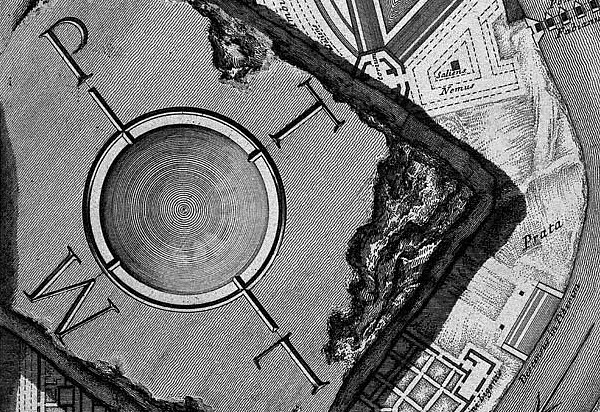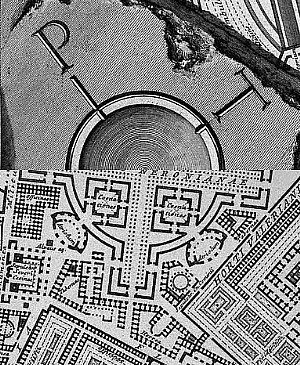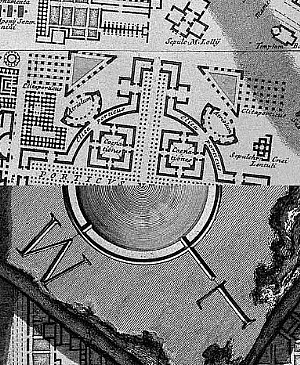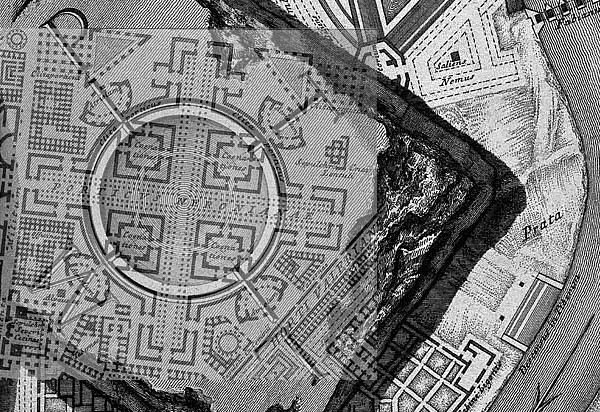excerpts from:
Catharine Edwards, Writing Rome: textual approaches to the city.
"One might compare the city of Rome, in which buildings of different periods were everywhere juxtaposed, to the funeral of a Roman aristocrat, where living members of the family wore masks to represent prominent figures of previous generations, mingling with one another indifferently across the centuries."
"For Romans, places might be thought to embody memory, to preserve a reassuring fixed version of the city's past, but places too, as we have seen, could be rewritten. The two huts of Romulus, with their competing claims to authenticity, were an uncomfortable reminder that Roman history was never simple or uncontested."
"The end of Livy Book 5 describes the rebuilding of Rome in the wake of the Gallic sack. The Romans were in a great hurry to rebuild, he writes, and for this reason there was no order to the new city, so that forma . . .urbis sit occupatae magis quam divisae similis, 'the arrangement of the city resembles that of a place taken over rather than portioned out'. Occupata here may be read as evoking Rome's recent occupation by the Gauls. Kraus draws our attention to Tacitus' reading of this Livian episode, which the latter author makes use of in his account of the destruction of Rome in the Neronian fire and the city's subsequent rebuilding. Tacitus' account presents Nero's fire as worse than the Gallic sack, for it causes destruction of monuments witnessing the origins of Rome. Rome is then rebuilt; large areas in the centre of the city are taken over for Nero's Domus Aurea. Nero's appropriation of the city is like that of a foreign enemy."
"While Propertius' treatment of Rome approaches the city topographically, Ovid chooses the Roman calendar as his organizing scheme. Ovid composed his poem at around the same time as was published an 'official' version of the Augustan calendar (incorporating the princips' new festivals), which seems to have been largely the work of the scholar Verrius Flaccus, a freedman of the emperor. Recent studies have suggestively examined the treatment of time in Ovid's Fasti, exploring the means by which the poet engages with Augustus' ideological appropriation of the calendar."
"Six temples in the Campus Martius originally constructed by triumphant generals of the republic now celebrated their foundation on 23 September, Augustus' birthday--a prelude to the monopolisation of triumphs by the imperial family after 19 BCE. It was not possible, then, to consider the organization of Roman time without engaging also with the spatial context through which Roman time was articulated."
| |
"The directional indices...
2007.09.08

"The directional indices T-M-P-L suggest templa, however their use is fairly conventional. Tramontane, literally "between the montains", is the name of the north wind or the north star as seen over the Alps. Meridióne is south, from the Latin meridianis for midday when Dianus, god of light and the sun, and male counterpart of Diana, is highest in the sky. Pončnte is west or the west wind, possibly from the Latin ponere "to put, or set down" in relation to the setting sun, while Levante is east, possibly from levare "to raise" in relation to the rising sun."
--R. James Aitken, Piranesi-Vico-Il Campo Marzio: Foundations and the Eternal City.
 
"...the inner circle of the Porticus Neronianae matches the circle of the compass/north arrow that Piranesi also delineated within the Ichnographia."

"The end of Livy Book 5 describes the rebuilding of Rome in the wake of the Gallic sack. The Romans were in a great hurry to rebuild, he writes, and for this reason there was no order to the new city, so that forma . . .urbis sit occupatae magis quam divisae similis, 'the arrangement of the city resembles that of a place taken over rather than portioned out'. Occupata here may be read as evoking Rome's recent occupation by the Gauls. Kraus draws our attention to Tacitus' reading of this Livian episode, which the latter author makes use of in his account of the destruction of Rome in the Neronian fire and the city's subsequent rebuilding. Tacitus' account presents Nero's fire as worse than the Gallic sack, for it causes destruction of monuments witnessing the origins of Rome. Rome is then rebuilt; large areas in the centre of the city are taken over for Nero's Domus Aurea. Nero's appropriation of the city is like that of a foreign enemy."
--Catharine Edwards, Writing Rome: textual approaches to the city.
|